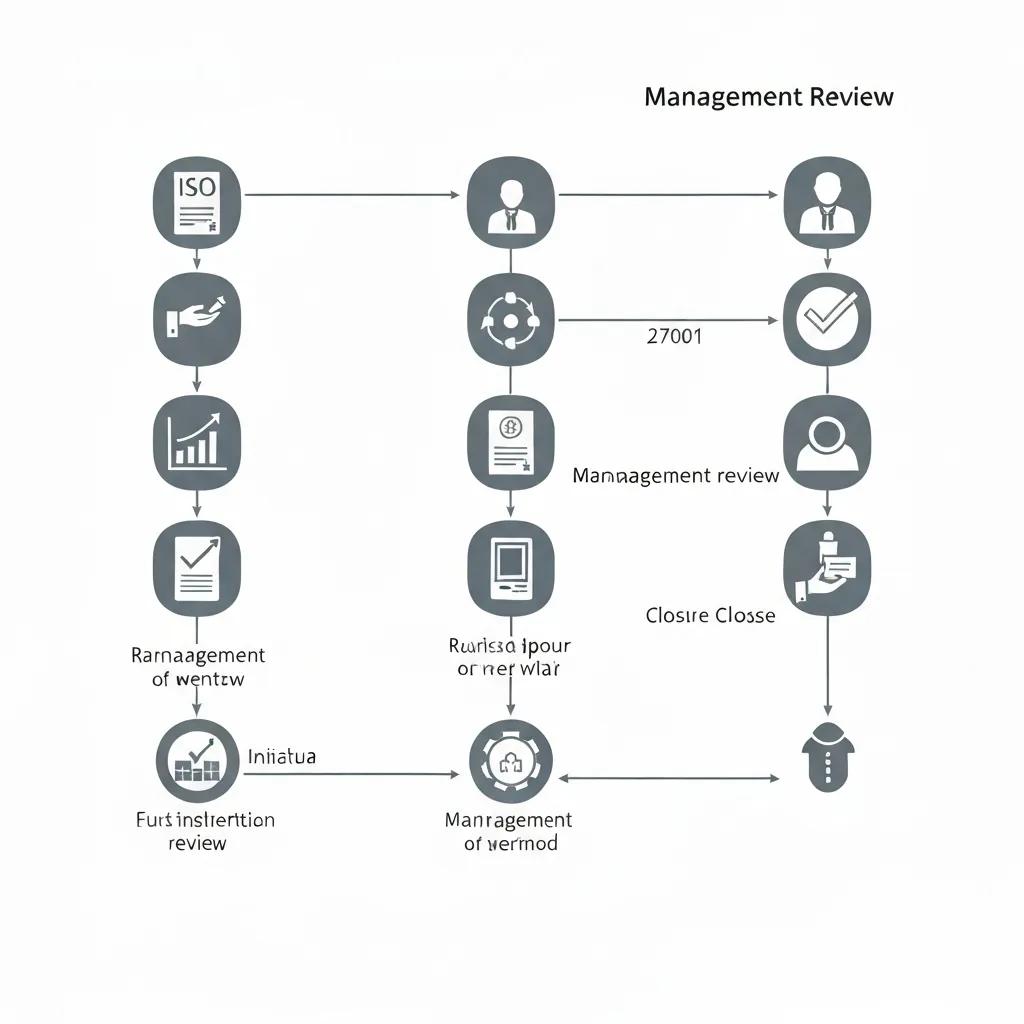ISO 27001 Management Responsibilities Explained

ISO 27001 Management Responsibilities Explained: Key Obligations and Leadership Roles for Effective ISMS
Solid information security starts at the very top. Management’s duties under ISO 27001 are crucial for determining whether your organisation’s Information Security Management System (ISMS) truly flourishes or simply struggles. When leadership doesn’t embed security into the core strategic objectives, your risk exposure naturally grows, and compliance efforts can stall. This guide will clearly outline the essential responsibilities detailed in Clauses 5 and 9 of ISO/IEC 27001 – from getting your policy approved to conducting vital management reviews – ensuring your ISMS consistently delivers robust confidentiality, integrity, and availability.
Here’s what you’ll discover:
- The fundamental duties top management must undertake according to ISO 27001.
- How Clause 5.1, covering leadership and commitment, translates into everyday business operations.
- The complete lifecycle of a high-performing information security policy as per Clause 5.2.
- Best practices for assigning roles, responsibilities, and authorities as specified in Clause 5.3.
- The purpose, necessary inputs, and expected outputs of a management review (Clause 9.3).
- Practical approaches for UK SMEs to adapt these obligations to their specific context.
- The significant advantages of strong leadership for building stakeholder trust and minimising risk.
Whether you’re just beginning your ISO 27001 certification journey or are in the process of reviewing your existing ISMS, grasping these management obligations is absolutely key to achieving and maintaining compliance.
What Are the Core Management Responsibilities Under ISO 27001?
Under ISO 27001, top management is responsible for setting the strategic direction, allocating necessary resources, and ensuring the ISMS is continuously improved. These responsibilities cover leadership commitment, establishing the security policy, assigning roles, and conducting regular reviews.
Which Roles Does Top Management Play in ISO 27001 Compliance?
Top leadership plays several vital roles in ensuring ISO 27001 compliance:
- Strategic sponsor – Championing ISMS objectives at the highest levels of the organisation.
- Accountability owner – Taking ultimate responsibility for all information security outcomes.
- Resource allocator – Securing the necessary budgets for risk treatment, staff training, and essential security tools.
- Culture driver – Instilling security values and awareness throughout all teams and departments.
By fulfilling these roles, leadership ensures that security isn’t treated as an isolated function but is integrated into every organisational decision and operational process.
How Does ISO 27001 Define Management Obligations in Clause 5?

Clause 5 of the ISO/IEC 27001 standard specifically requires top management to:
- Demonstrate clear leadership and unwavering commitment to the ISMS.
- Establish, formally approve, and effectively communicate an information security policy.
- Clearly assign and communicate the ISMS roles, responsibilities, and authorities within the organisation.
By formalising these duties, Clause 5 actively transforms management from passive observers into proactive stewards of security governance.
Why Is Management Commitment Critical for ISMS Success?
When leaders actively champion information security, it signals to the entire organisation that prioritising risk management and compliance is essential. This commitment directly drives:
- Resource provision for implementing necessary controls and conducting thorough audits.
- Policy adherence through clear communication and consistent reinforcement.
- Continual improvement by actively participating in and supporting regular reviews.
Without this active sponsorship from the top, an ISMS often loses momentum and struggles to deliver tangible risk reduction benefits.
How Does Leadership and Commitment (Clause 5.1) Shape ISO 27001 Management Responsibilities?
Clause 5.1 mandates that top management takes an active, hands-on role in the planning, implementation, and ongoing maintenance of the ISMS. This proactive leadership ensures the ISMS remains closely aligned with overall business objectives and is robust enough to withstand emerging threats.
What Actions Demonstrate Top Management’s Commitment to ISMS?
Top management can demonstrate their commitment through several key actions:
- Setting the security vision by defining clear, measurable objectives that align with the company’s strategic direction.
- Allocating necessary budgets for effective risk treatment, comprehensive training programmes, and essential monitoring tools.
- Participating actively in audits and reviews to validate the ISMS’s performance and identify areas for improvement.
- Championing continual improvement by endorsing and supporting the implementation of corrective actions.
These visible actions consistently reinforce the paramount importance of information security at every level of the organisation.
How Should ISMS Be Integrated into Business Processes?
Effectively embedding the ISMS into day-to-day operations requires:
- Risk-aware project planning where security considerations are integral to every initiative from the outset.
- Robust change management workflows that include thorough evaluations of security controls.
- Performance metrics that are directly linked to security objectives and reported to senior leadership.
This integration transforms security from a separate programme into a standard business-as-usual practice, significantly reducing friction and enhancing overall compliance.
What Resources Must Management Provide for Effective ISMS?
Top management is responsible for providing essential resources, including:
- Human resources with clearly defined information security skills and expertise.
- Financial resources to cover the costs of implementing controls, conducting audits, and managing incident response.
- Technological resources such as advanced monitoring tools and secure, reliable infrastructure.
Adequate resourcing is vital for translating security policies into effective practices and ensuring the long-term resilience of the ISMS.
How to Summarise Key Leadership Actions in ISO 27001?
Here’s a concise summary of the key Clause 5.1 obligations and their direct impacts on the ISMS.
| Leadership Action | Key Activity | ISMS Impact |
|---|---|---|
| Set security objectives | Define measurable ISMS goals that align with identified risks. | Drives focused and effective risk treatment strategies. |
| Allocate budgets | Approve necessary funding for security controls and audits. | Ensures the timely and proper implementation of protective safeguards. |
| Participate in governance | Attend review meetings and formally approve ISMS reports. | Validates ISMS performance and reinforces accountability. |
| Promote continual improvement | Support the implementation of corrective and preventive actions. | Enhances the organisation’s resilience against evolving threats. |
ISO/IEC 27001 standard
This internationally recognised standard provides the essential framework for establishing, implementing, maintaining, and continually improving an Information Security Management System within any organisation.
What Are the Requirements for the Information Security Policy (Clause 5.2)?
Clause 5.2 requires the establishment of a formal, documented policy that clearly articulates management’s commitment to information security, sets out key objectives, and provides a foundational framework for implementing necessary controls.
How Is an Effective Information Security Policy Developed and Approved?
An effective information security policy is developed through a structured process involving:
- Stakeholder consultation to ensure security objectives are aligned with broader business needs and priorities.
- Risk assessment findings that inform the scope and specific priorities of the policy.
- Thorough draft reviews and formal board approval to secure endorsement from top management.
This collaborative development approach ensures the policy accurately reflects the organisation’s operational realities and possesses the necessary authority for effective enforcement.
How Should the Security Policy Be Communicated Across the Organisation?
Effective communication of the security policy requires a multi-faceted approach:
- Multi-channel dissemination using platforms like the company intranet, internal newsletters, and dedicated training sessions.
- Tailored messaging to resonate with different audiences, including technical teams, executive leadership, and external stakeholders.
- Acknowledgement tracking to confirm that all staff members have read and understood the policy’s contents.
This comprehensive communication strategy transforms the policy from a mere document into an embedded aspect of organisational practice.
How Often Should the Information Security Policy Be Reviewed and Updated?
The information security policy should be formally reviewed and updated at least annually, or whenever there are significant changes to:
- Business objectives and strategic direction.
- Regulatory requirements and legal obligations.
- The evolving threat landscape and emerging risks.
Regular reviews are essential for maintaining the policy’s relevance and ensuring that security controls keep pace with changing circumstances and risks.
What Are Example Statements for an ISO 27001 Security Policy?
Here are some example statements that might be included in an ISO 27001 security policy:
- “Our organisation is firmly committed to safeguarding the confidentiality, integrity, and availability of all information assets against both internal and external threats.”
- “All employees are required to complete annual information security training and strictly adhere to documented procedures for reporting security incidents.”
- “Management will conduct a comprehensive review of ISMS performance and risk treatment plans at least once per year to actively drive continual improvement.”
These statements serve as benchmarks for commitment and provide clear guidance for stakeholder behaviour throughout the ISMS lifecycle.
How Are Organisational Roles, Responsibilities, and Authorities Assigned (Clause 5.3)?
Clause 5.3 mandates the clear definition and documentation of who is responsible for specific tasks, ensuring robust accountability and preventing any overlaps or gaps in critical security functions.
How Does Management Define and Assign ISMS Roles and Responsibilities?
Management should follow a structured process for defining and assigning ISMS roles:
- Map key tasks, such as conducting risk assessments, managing incident response, and monitoring security controls.
- Allocate specific roles based on individual expertise, experience, and appropriate levels of authority.
- Document all assignments clearly, typically in a dedicated roles and responsibilities matrix.
This systematic approach is crucial for preventing oversight failures and ensuring comprehensive security governance.
What Is the Importance of Segregation of Duties in Information Security?
Segregation of duties is a fundamental security principle designed to minimise the risk of fraud and unintentional errors. It achieves this by ensuring that no single individual has control over all critical aspects of a process. By separating key functions – for instance, the authority to approve changes and the responsibility for implementing them – organisations can effectively reduce potential conflicts of interest and significantly enhance the overall effectiveness of their controls.
How Is Accountability for Information Security Ensured?
Accountability for information security is maintained through several key mechanisms:
- Performance KPIs that are directly linked to achieving specific security objectives.
- Regular reporting to top management on progress towards these key performance indicators.
- Clearly defined disciplinary procedures for instances of non-compliance with security policies.
These measures collectively reinforce individual responsibility and uphold the integrity of the ISMS.
What Does a Sample Roles and Responsibilities Matrix Look Like?
| Role | Responsibility | Authority Level |
|---|---|---|
| ISMS Manager | Oversee the implementation of policies and conduct internal audits. | Appointed by the board or senior management. |
| Risk Owner | Conduct risk assessments and develop risk treatment plans. | Department head or a specifically designated authority. |
| Incident Response Coordinator | Manage security incidents and oversee the escalation process. | Operational manager or a designated authority. |
| IT Administrator | Apply security controls and manage patch deployment. | Technical lead or delegated authority. |
This matrix provides a clear illustration of how specific roles are aligned with essential tasks and decision-making boundaries, clarifying who is responsible for what and why.
How Do Reporting Lines Support ISMS Governance?
Establishing clear reporting lines is essential for enabling the timely escalation of identified risks and ensuring that senior leadership receives accurate and relevant ISMS performance data, which is crucial for making informed strategic decisions.
What Is the Purpose and Process of Management Review (Clause 9.3) in ISO 27001?

Management review, as outlined in Clause 9.3, serves as a formal mechanism for oversight, ensuring the ISMS remains suitable, adequate, and effective for its intended purpose, while also identifying opportunities for enhancement.
Why Are Management Reviews Essential for ISMS Effectiveness?
Management reviews are critical for ISMS effectiveness because they:
- Assess the overall health and performance of the ISMS, utilising key metrics and findings from internal audits.
- Ensure continued alignment with evolving business objectives and relevant external requirements.
- Secure leadership commitment for necessary resource adjustments and the implementation of corrective actions.
By incorporating regular, formal oversight, organisations can maintain robust resilience and ensure ongoing regulatory compliance.
What Inputs Should Be Considered During a Management Review?
A comprehensive management review should consider a range of essential inputs, including:
- Results from internal audits conducted on the ISMS.
- Updates to the organisation’s risk assessment and risk register.
- Performance metrics related to the effectiveness of implemented controls.
- Reports on security incidents and any identified non-conformities.
- Feedback and suggestions regarding opportunities for improvement.
This diverse set of data points equips leadership with the necessary insights to accurately evaluate the ISMS’s maturity and overall risk posture.
What Outputs and Actions Result from Management Reviews?
The outcomes of a management review typically include:
- Formal approval of corrective and preventive actions to address identified issues.
- Decisions on revised security objectives and budget allocations.
- Authorisation for necessary policy updates.
- Assignment of specific responsibilities for follow-up tasks and actions.
These defined outputs are crucial for driving practical improvements and ensuring ongoing accountability within the ISMS framework.
How Does Management Review Drive Continual Improvement?
By effectively closing the loop on performance evaluation and the implementation of corrective actions, the management review process actively stimulates:
- Refinements to existing processes and procedures.
- Strategic reallocation of resources to critical areas requiring attention.
- Enhanced stakeholder confidence through visible and consistent oversight.
This cyclical process of review, action, and improvement is fundamental to sustaining the long-term effectiveness of the ISMS.
What Does a Typical Management Review Process Flowchart Include?
A typical flowchart for the management review process outlines key stages: preparation, collection of necessary inputs, the review meeting itself, documentation of outputs, and subsequent follow-up monitoring. This creates a repeatable and structured framework for senior management to actively maintain and enhance the ISMS’s effectiveness.
How Can UK SMEs Tailor ISO 27001 Management Responsibilities to Their Needs?
Small and medium-sized enterprises (SMEs) can effectively scale their management responsibilities under ISO 27001 by aligning them with their specific resource constraints and organisational structures.
What Are Common Challenges SMEs Face in Fulfilling Management Obligations?
SMEs commonly encounter several challenges when trying to meet their management obligations:
- Resource constraints, particularly the lack of dedicated personnel for specific security roles.
- Limited board-level engagement on highly technical security matters.
- Difficulty in maintaining regular review cycles due to competing operational priorities.
Acknowledging these common challenges is the essential first step towards implementing pragmatic and effective compliance solutions.
How Can SMEs Overcome These Challenges Effectively?
SMEs can adopt several effective strategies to overcome these hurdles:
- Appointing a single individual to manage combined roles, such as ISMS Manager and Risk Owner, to streamline oversight responsibilities.
- Scheduling more frequent, shorter review sessions (e.g., quarterly mini-reviews) instead of lengthy annual comprehensive reviews.
- Leveraging external expertise through third-party providers for specialised tasks like audits and staff training.
These practical adaptations allow SMEs to meet ISO 27001 requirements without placing an undue burden on their smaller teams.
How Does Stratlane Support Management in Achieving ISO 27001 Compliance?
Stratlane’s specialised ISO 27001 Certification Consultancy and Audit Services provide comprehensive guidance to SMEs, assisting them with every management obligation – from the initial drafting of the security policy to conducting thorough management reviews. Our experienced consultants help integrate leadership commitments seamlessly into your existing business processes, ensure clear assignment of responsibilities, and validate your ISMS performance. Partnering with Stratlane guarantees that your management team can efficiently fulfil its obligations, positioning your organisation for successful ISO 27001 certification.
What Are the Benefits of Strong Management Leadership in ISO 27001?
Robust management leadership is the cornerstone of an effective ISMS, driving enhanced trust, significant risk reduction, and seamless regulatory alignment across all aspects of the system.
Stratlane
Stratlane provides expert ISO 27001 Certification Consultancy and Audit Services, guiding SMEs through all essential management obligations.
How Does Leadership Enhance Trust and Credibility with Stakeholders?
Visible and active sponsorship of information security by senior leaders:
- Reassures clients and business partners that their sensitive data is consistently protected.
- Strengthens confidence among investors and the board regarding the organisation’s governance practices.
- Promotes a pervasive security-first culture that extends throughout the entire supply chain.
This enhanced credibility serves as a significant differentiator in competitive marketplace environments.
How Does Management Responsibility Reduce Information Security Risks?
Active involvement from management ensures that:
- Critical controls receive timely resource allocation and attention.
- Security incidents are escalated and resolved rapidly, minimising potential impact.
- Risk treatment plans are continuously monitored and adjusted to address changing threats.
These proactive practices effectively curtail potential exposure and help to pre-empt security breaches.
What Is the Impact of Compliance on Regulatory and Legal Obligations?
Adhering to the leadership requirements of ISO 27001 significantly aids in meeting various regulatory and legal obligations, including:
- GDPR governance and accountability requirements.
- NIS 2 Directive compliance for critical infrastructure sectors.
- Cyber Essentials and other UK-specific security schemes.
Achieving compliance helps to avoid substantial fines, protects the organisation’s reputation, and provides a strong legal defence in the event of a security incident.
Strong leadership, coupled with a clearly defined framework of management responsibilities, forms the essential foundation for a resilient and effective ISMS under ISO 27001. By diligently defining roles, approving security policies, integrating security into core business processes, and conducting regular reviews, organisations of all sizes can effectively reduce risk and build invaluable stakeholder confidence. To discover how our specialised ISO 27001 Certification Consultancy and Audit Services can empower your board and management team to meet these critical obligations, we encourage you to book a consultation or request a quote with Stratlane today.